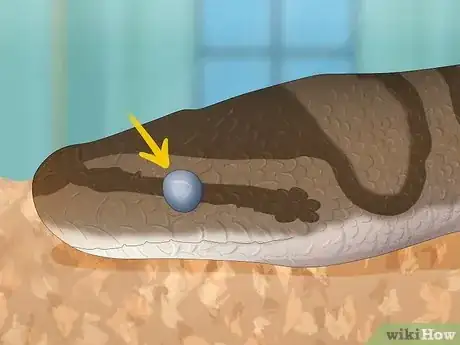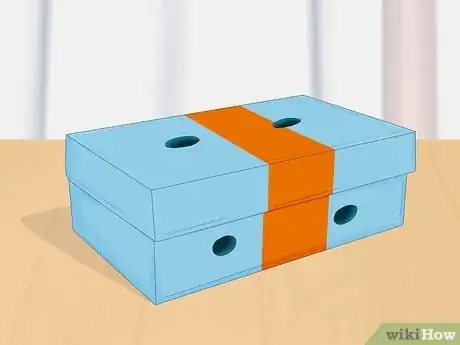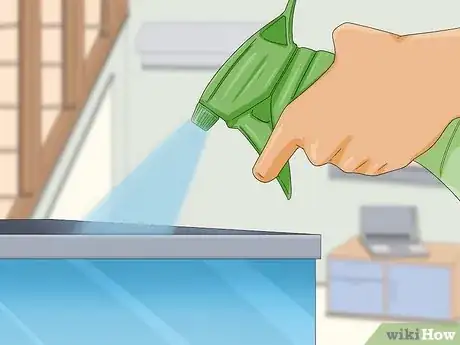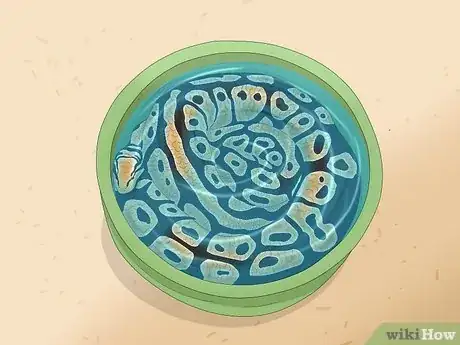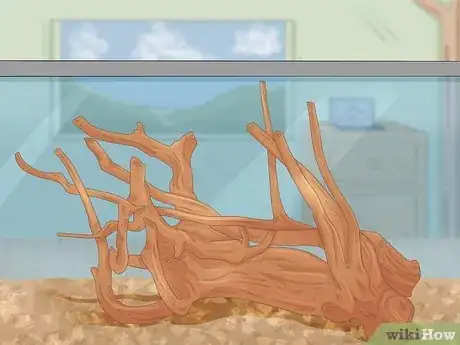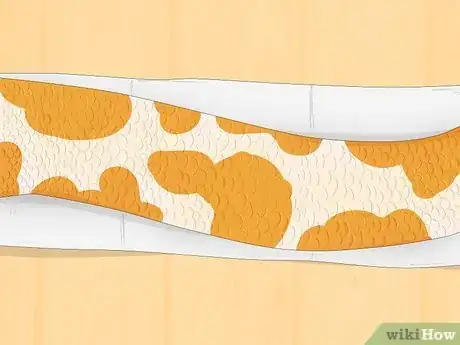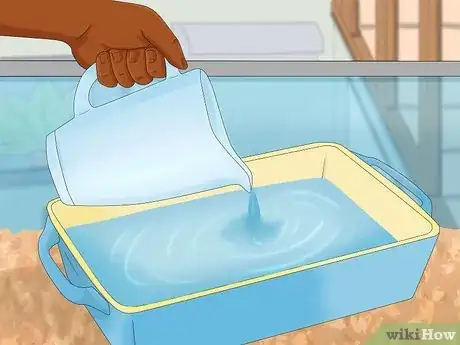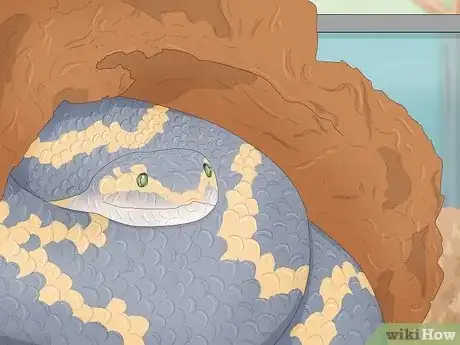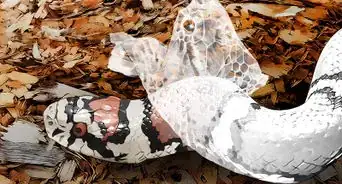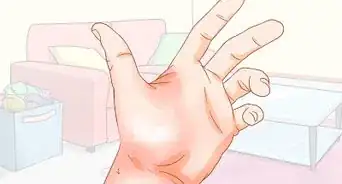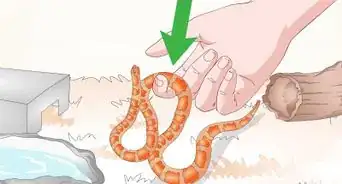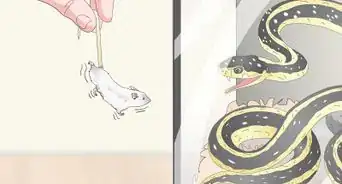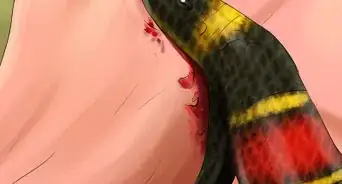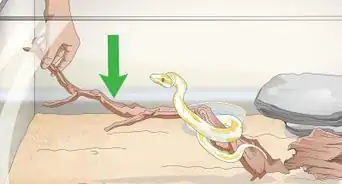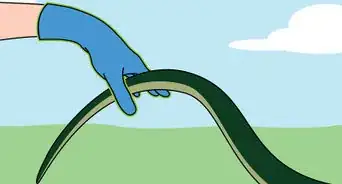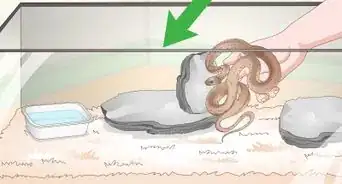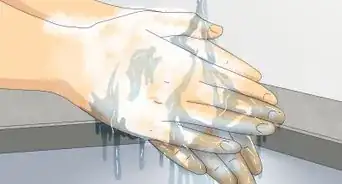This article was co-authored by Jeff Jensen. Jeff Jensen is a Reptile Specialist and the Owner of The Reptile Zone out of Bend, Oregon. With decades of experience with reptiles and wildlife, Jeff specializes in providing advice and guidance on proper reptile care. As a former science teacher and employee of the San Antonio Zoo and an accomplished herpetologist, Jeff’s dedication to knowledge and ethical pet trade practices led to The Reptile Zone being awarded a “Mark of Excellence” Award by Intrepid Marketing in 2018.
wikiHow marks an article as reader-approved once it receives enough positive feedback. This article received 16 testimonials and 100% of readers who voted found it helpful, earning it our reader-approved status.
This article has been viewed 407,647 times.
Snakes shed regularly throughout their life to enable growth. Shedding usually takes about one to two weeks. Although this is a completely natural process, there are certain steps that you must take to care for a shedding snake. Make sure you foster a hospitable environment for your snake by adding extra water and humidity to the cage. Provide the snake with a basin of water and coarse materials to help it get rid of its skin. If you notice any complications, such as an incomplete shedding, seek the help of a veterinarian.
Steps
How to Provide a Supportive Environment for a Shedding Snake
-
1Learn the signs your snake is about to shed. You want to start preparing for the shedding process before it even begins. To do so, you'll have to keep an eye on your snake and watch for the signs that it is about to shed. When you start noticing signs, begin to prepare.
- Watch your snake's eyes. They will have a dull, blueish white appearance just before the snake begins to shed.
- You should also take note of the snake's current skin. The skin will begin to dull just before shedding.
-
2Create a moist shedding box. Snakes need a lot of humidity to shed properly.[1] One way you can increase the humidity in your snake's environment is with a shedding box. Take a box, like a shoebox, and make sure it is well ventilated by poking holes throughout. Place damp paper towels within the box, allowing the snake a damp place to shed.[2]Advertisement
-
3Mist the cage with lukewarm water. You can also try misting the cage lightly to increase humidity. Take a spray bottle and fill it with lukewarm water. You can also mist your snake with water just before shedding, if your snake will allow this.[3]
-
4Manage the cage's humidity. Monitor the humidity in your snake's environment. You can get a device at a pet store, or a department store, that measures humidity in your snake's cage. During the shedding process, snakes need a cage that is between 50 and 70% humidity.[4] If the humidity in your snake's cage is below this level, there are several steps you can take to improve humidity.[5]
- Add a large water dish to the cage.
- Cover the top of the cage. If you have a screen top on the cage, you can safely cover half the top to increase humidity.
- Try using orchid bark substrate, which refers to the bedding that lines the bottom of the cage. Orchid bark tends to hold more humidity than other products.
How to Help with the Shedding Process
-
1Place a basin of warm water in your snake's aquarium. When your snake begins shedding, you'll notice flakes of skin beginning to come off. During this time, add a warm basin of water to your snake's cage. You can help your snake shed by placing a basin of warm water inside its enclosure. Your snake will be able to bath in the water, allowing its skin to come off more easily.[6]
- Pick a basin that is big enough to hold your snake's entire body.
- Add enough water that your snake can get its entire body wet. However, do not add so much water that your snake will be submerged under water when it enters the basin.
-
2Add coarse materials to the snake's container. Snakes can also rub skin off by crawling over coarse material. Uneven materials, like tree branches and stones, can be very helpful to shedding snakes. You can also use patches of tree bark, pine cones, and other coarse materials you find outside.[7]
- If your snake is rubbing its nose against objects in the cage, it is trying to get its skin off during the shedding process. If you notice your snake doing this, it is particularly important that you add coarse materials to your snake's cage.
-
3Put your snake between several layers of paper towels. If your snake is struggling to shed on its own, you may have to assist. Get several layers of paper towels damp. Then, remove your snake from its shed and place it between the towels. Allow your snake to crawl and squirm between the towels. The combination of humidity and friction should help remove excess skin.[8]
-
4Clean the cage after shedding. After your snake completes shedding, you will notice excess skin throughout the cage. Skin may appear in small, crumpled piles. It may also be in dry and tube like sections throughout the cage. Remove any excess skin from the cage after your snake finishes shedding.
- Snakes frequently defecate after the shedding process. Use gloves when cleaning the cage, as you may have to pick up fecal matter as well.
-
5Provide extra water. Snakes often consume large quantities of water after shedding. Keep an eye on your snake's water dish. Make sure you refill it frequently after your snake finishes shedding. It is not unusual that you will find yourself refilling the water dish more than usual in the days following a shed.
How to Manage Complications
-
1See a vet in the event of an incomplete shedding. Despite your best efforts, your snake may not shed completely. If your snake does not finish shedding within one to two weeks, see a vet. A veterinarian can help remove the remaining skin and examine your snake. Usually, shedding problems are caused by a lack of humidity, but you'll want an exam to rule out any possible underlying health problems.[9]
- Never try to peel off excess skin yourself, especially not skin around a snake's eyes or mouth.
-
2Foster a stress free environment. Stress is a possible cause for improper shedding. If your snake did not shed correctly, work on improving your snake's stress level. Make sure the snake has a quality environment, and limit handling your snake.[10]
- Keep the humidity level comfortable. You should also make sure your snake has a lot of hiding places in its cage. Snakes are solitary pets, and crave alone time. Keep boxes and enclosures in your snake's cage so it can get alone time.
- Do not handle your snake too frequently. Snakes may dislike being handled and, if handled too much, a snake may learn to think of you as a predator. Do not handle your snake for more than 30 minutes at a time, and only do so a few times per week.
-
3Make sure to see your vet regularly. Regular veterinary visits can help a snake shed smoothly in the future. In rare cases, difficulty shedding is caused by a medical concern. If you take your snake in for regular checkups, a vet can diagnose and correct issues before they lead to problems shedding. [11]
Expert Q&A
-
QuestionIs shedding painful for snakes?
 Pippa Elliott, MRCVSDr. Elliott, BVMS, MRCVS is a veterinarian with over 30 years of experience in veterinary surgery and companion animal practice. She graduated from the University of Glasgow in 1987 with a degree in veterinary medicine and surgery. She has worked at the same animal clinic in her hometown for over 20 years.
Pippa Elliott, MRCVSDr. Elliott, BVMS, MRCVS is a veterinarian with over 30 years of experience in veterinary surgery and companion animal practice. She graduated from the University of Glasgow in 1987 with a degree in veterinary medicine and surgery. She has worked at the same animal clinic in her hometown for over 20 years.
Veterinarian Shedding isn't painful as a lubricating layer of moisture builds between the old and new skin. However, snakes do feel vulnerable while shedding and tend to hide away.
Shedding isn't painful as a lubricating layer of moisture builds between the old and new skin. However, snakes do feel vulnerable while shedding and tend to hide away. -
QuestionWhat do snakes do after they shed their skin?
 Pippa Elliott, MRCVSDr. Elliott, BVMS, MRCVS is a veterinarian with over 30 years of experience in veterinary surgery and companion animal practice. She graduated from the University of Glasgow in 1987 with a degree in veterinary medicine and surgery. She has worked at the same animal clinic in her hometown for over 20 years.
Pippa Elliott, MRCVSDr. Elliott, BVMS, MRCVS is a veterinarian with over 30 years of experience in veterinary surgery and companion animal practice. She graduated from the University of Glasgow in 1987 with a degree in veterinary medicine and surgery. She has worked at the same animal clinic in her hometown for over 20 years.
Veterinarian After shedding their skin, the snake goes back to their normal habits and routines.
After shedding their skin, the snake goes back to their normal habits and routines. -
QuestionCan you feed a snake while it's shedding?
 Pippa Elliott, MRCVSDr. Elliott, BVMS, MRCVS is a veterinarian with over 30 years of experience in veterinary surgery and companion animal practice. She graduated from the University of Glasgow in 1987 with a degree in veterinary medicine and surgery. She has worked at the same animal clinic in her hometown for over 20 years.
Pippa Elliott, MRCVSDr. Elliott, BVMS, MRCVS is a veterinarian with over 30 years of experience in veterinary surgery and companion animal practice. She graduated from the University of Glasgow in 1987 with a degree in veterinary medicine and surgery. She has worked at the same animal clinic in her hometown for over 20 years.
Veterinarian Yes, you can offer food. However, most snakes go off their food while shedding and will refuse to eat. If you don’t know your snake’s habits well enough yet to know whether or not it’ll eat its food, then you can always try giving it something to see what happens. If you decide to offer food to the snake, it can decide for itself if it wishes to eat but if it chooses not to, then remove the food to avoid rotting and bacterial problems.
Yes, you can offer food. However, most snakes go off their food while shedding and will refuse to eat. If you don’t know your snake’s habits well enough yet to know whether or not it’ll eat its food, then you can always try giving it something to see what happens. If you decide to offer food to the snake, it can decide for itself if it wishes to eat but if it chooses not to, then remove the food to avoid rotting and bacterial problems.
Warnings
- It may appear as if your snake is ill – not eating, changing color and appearance and hiding more than usual but there is no reason to take them to the Vet’s just yet, shedding is normal and must happen in order for the snake to grow.⧼thumbs_response⧽
- Leave your snake alone for the shedding process – handling it and harassing it will only make it more stressful for the animal and could cause the shedding to occur in pieces rather than all at once. Snakes may also be more aggressive when shedding.⧼thumbs_response⧽
References
- ↑ Jeff Jensen. Reptile Specialist. Expert Interview. 8 April 2021.
- ↑ http://www.drsfostersmith.com/pic/article.cfm?aid=813
- ↑ http://www.drsfostersmith.com/pic/article.cfm?aid=813
- ↑ http://www.drsfostersmith.com/pic/article.cfm?aid=813
- ↑ http://www.lllreptile.com/articles/99-increasing-cage-humidity
- ↑ http://animals.mom.me/snake-shes-shedding-10413.html
- ↑ http://animals.mom.me/snake-shes-shedding-10413.html
- ↑ http://www.drsfostersmith.com/pic/article.cfm?aid=813
- ↑ http://www.drsfostersmith.com/pic/article.cfm?aid=813
About This Article
To care for a shedding snake, mist its aquarium with water to keep the area humid. You can also create a moist shedding box by poking holes in a shoe box, placing damp paper towels inside, and putting it in the aquarium. Adding coarse materials like tree branches, tree bark, and pine cones can help your snake shed its skin more easily. Be sure to provide extra water, since snakes consume large quantities of it after shedding! For more tips on aiding your snake in the shedding process, read on!
